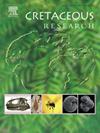The Bauru Group (Campanian–Maastrichtian) has one of the richest fossil records of Cretaceous in South America. All dinosaur fossils from this unit were assigned to Saurischia, most of them poorly preserved. We present the histological and taphonomic analysis of a dinosaur dorsal rib fragment from the Marília Formation in the western state of Minas Gerais. Thin sections were prepared to describe the microstructures of the bone tissue and the fossilization processes involved in preserving the specimen. An elemental analysis was also performed to verify the chemical composition of the fossil and rock matrix. Haversian bone was identified in the rib cortex, and no growth marks or an external fundamental system were found. The rib probably belonged to a saurischian dinosaur because of its plank shape and elliptical cross-section. Hypotheses regarding taphonomic processes were inferred. An extended period of subaerial exposure, followed by high-energy transport, was interpreted due to extensive fractures and signs of abrasion on the outer surface of the bone. Pyrite pseudomorphs (framboids) indicate that the bone was deposited in a reductive environment. After burial, the rapid precipitation of calcite and alkaline stability allowed the preservation of apatite during the recrystallization phase. The manganese hydroxides were deposited on apatite crystals during early diagenesis. We concluded that the fossil rib presented a common taphonomic bias identified among vertebrate fossils of the Bauru Group, which is associated with the exposure of the bones to arid and semiarid climates, their transport into the depositional environments and pedogenetic influence during fossil diagenesis.


